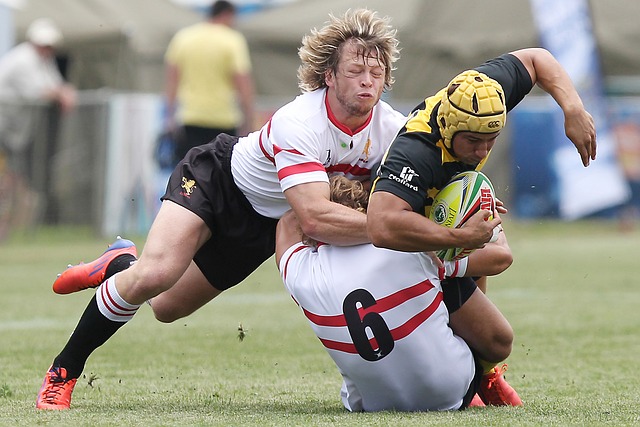
The global rugby apparel market is forecasted to grow steadily, with a projected CAGR of 11.3% during the period from 2022 to 2032. In 2022, the market is expected to achieve a valuation of US$ 1,022.85 million. Due to increasing demand worldwide, the rugby apparel market is anticipated to reach US$ 2,984 million by 2032.
More people around the world want to play rugby games, and there are more players. This will help make this market grow in coming years. This group includes both people who play rugby for a job and others who like the game as a fun pastime.
More and more rugby games are happening, so people all over the world accept wearing rugby clothes. This has boosted the whole industry. More games and tournaments, along with more support from sponsors for rugby clothing worn in the game will help make this market grow over a certain time period. People are paying more attention to use eco-friendly things for comfort and they’re switching towards green rugby gear. This is making the demand grow and market expand too.
Request Sample Report:
https://www.futuremarketinsights.com/reports/sample/rep-gb-15339
Rugby gear provides flexibility of movement and comfort, as well as moisture management, which is driving market expansion. Another factor driving the global market demand for rugby apparel is the growing female participation in the sport.
However, because rugby is not a popular sport among the general public, it is likely to limit market growth over the forecast period. Furthermore, limited commercial exposure for products is projected to stymie market expansion in the future years. In contrast, increased investments in this sport combined with innovation in apparel is projected to create profitable prospects for the market throughout the forecast period.
Growth Drivers:
- Growing Popularity of Rugby: The increasing popularity of rugby as a global sport, particularly in regions like Europe, Oceania, and parts of Asia, is driving the demand for rugby apparel. As more people engage in playing and watching rugby, there is a corresponding rise in the demand for high-quality apparel.
- Expansion of Rugby Leagues and Tournaments: The proliferation of rugby leagues and tournaments worldwide, including international competitions like the Rugby World Cup, Six Nations Championship, and Super Rugby, creates a continuous demand for rugby apparel. These events attract a large audience and drive merchandise sales.
- Innovations in Fabric Technology: Advancements in fabric technology have led to the development of high-performance materials that offer superior comfort, durability, and moisture-wicking properties. Manufacturers are leveraging these innovations to create cutting-edge rugby apparel that enhances players’ performance and comfort.
- Growing Fitness and Athleisure Trend: The global trend towards a more health-conscious lifestyle and the increasing popularity of athleisure wear are positively impacting the rugby apparel market. Rugby apparel, with its association with athleticism and durability, is appealing to consumers seeking functional yet stylish activewear.
- Strategic Marketing and Sponsorships: Strategic marketing initiatives and sponsorships by major apparel brands, sports teams, and athletes are driving visibility and brand recognition in the rugby apparel market. Endorsements from popular rugby players and teams play a crucial role in influencing consumer preferences and driving sales.
Industry Restraints:
- High Competition and Market Saturation: The rugby apparel market is highly competitive, with numerous established brands and new entrants vying for market share. This intense competition often leads to price wars and margin pressures, particularly for smaller players in the market.
- Economic Uncertainty and Consumer Spending: Economic downturns and fluctuations in disposable income can negatively impact consumer spending on non-essential items like sports apparel, including rugby gear. During periods of economic uncertainty, consumers may prioritize essential purchases over discretionary spending on sports-related merchandise.
- Supply Chain Disruptions: Disruptions in the global supply chain, such as raw material shortages, manufacturing delays, or logistics challenges, can hinder the timely production and delivery of rugby apparel. Events like natural disasters, trade disputes, or public health crises (e.g., the COVID-19 pandemic) can exacerbate these supply chain disruptions.
- Regulatory Compliance and Standards: Compliance with regulatory requirements and industry standards, such as safety regulations, labor laws, and environmental standards, can pose challenges for rugby apparel manufacturers. Adhering to these regulations adds costs and complexity to the production process, particularly for companies operating in multiple regions with varying regulatory frameworks.
- Seasonal Demand Fluctuations: The seasonal nature of rugby competitions and the associated demand for rugby apparel can lead to fluctuations in sales throughout the year. Peak seasons, such as during major tournaments or the holiday shopping season, may drive higher sales, while off-peak periods may experience slower demand, requiring effective inventory management strategies.
Key Takeaways from the Market Study
- In 2022, the global rugby apparel market is estimated to have a global market size of US$ 1,022.85 Million.
- By product type, the upper wear segment will account for 51% of the global market share in 2022 and grow with a 11.8% CAGR during the forecast period.
- By product type, the bottom wear segment will exhibit a 10.3% CAGR during 2022-2032.
- The APAC rugby apparel market is expected to grow with a 11% CAGR during the forecast period.
- The European region is projected to acquire 41% of the global market share in 2022 and grow with a 12.2% CAGR during the forecast period.
“Growing demand for fresh and innovative rugby apparel designs among players is pushing the market size. Another major element driving the market is the growing number of females playing rugby and participating in rugby games around the world,” comments a Future Market Insights analyst.
Request the Full Report Methodology Now!
https://www.futuremarketinsights.com/request-report-methodology/rep-gb-15339
Competitive Landscape
The market is highly fragmented and competitive, with worldwide companies pursuing product innovation methods. A range of activities are being undertaken by key industry actors to increase their market position. These processes include mergers, collaborations, and acquisitions, as well as the development and introduction of innovative products, global expansion, and others.
- Nike frequently uses social media outlets to promote brand visibility, which also aids in product sales volume and also additionally promotes through various media in order to propagate social messages regarding women’s empowerment and sports participation.
- For the upcoming 2022/23 season, Canterbury launched the redesigned Ireland Rugby Home jersey in 2022. This will be worn by the men’s and women’s teams, along with a selection of training equipment all rugby fans can enjoy. This year’s shirt reflects the strength and solidarity of Irish players, fans, and supporters as they prepare for upcoming test matches against strong opponents.
Key Players Are:
- Adidas AG
- Nike Inc.
- BADGER RUGBY LTD.
- Canterbury
- KOOGA
- Decathlon SA
- Gilburt Rugby
- MACRON SPA
- O’Neills Irish International Sports Co. Ltd.
- Olympus Rugby
More Valuable Insights
Future Market Insights, in its new offering, presents an unbiased analysis of the global rugby apparel market, presenting historical analysis from 2017 to 2021 and forecast statistics for the period of 2022-2032.
The study reveals essential insights on the basis of product type (upper wear, bottom wear and socks) and region (North America, Latin America, Europe, Asia Pacific, and Middle East & Africa).
Gain Immediate Access to Detailed Market Insights: https://www.futuremarketinsights.com/checkout/15339
Key Segments Covered in the Rugby Apparel Market Report
By Type:
- Rugby Upper Wear
- Rugby Bottom Wear
- Rugby Socks
By Region:
- North America
- Latin America
- Europe
- Asia Pacific
- Middle East & Africa
Author
Sneha Varghese (Senior Consultant, Consumer Products & Goods) has 6+ years of experience in the market research and consulting industry. She has worked on 200+ research assignments pertaining to Consumer Retail Goods.
Her work is primarily focused on facilitating strategic decisions, planning and managing cross-functional business operations, technology projects, and driving successful implementations. She has helped create insightful, relevant analysis of Food & Beverage market reports and studies that include consumer market, retail, and manufacturer research perspective. She has also been involved in several bulletins in food magazines and journals.
About Future Market Insights (FMI)
Future Market Insights, Inc. (ESOMAR certified, recipient of the Stevie Award, and a member of the Greater New York Chamber of Commerce) offers profound insights into the driving factors that are boosting demand in the market. FMI stands as the leading global provider of market intelligence, advisory services, consulting, and events for the Packaging, Food and Beverage, Consumer, Technology, Healthcare, Industrial, and Chemicals markets. With a vast team of ~400 analysts worldwide, FMI provides global, regional, and local expertise on diverse domains and industry trends across more than 110 countries.
Contact Us:
Future Market Insights Inc.
Christiana Corporate, 200 Continental Drive,
Suite 401, Newark, Delaware – 19713, USA
T: +1-845-579-5705
For Sales Enquiries: sales@futuremarketinsights.com
Website: https://www.futuremarketinsights.com
LinkedIn| Twitter| Blogs | YouTube




